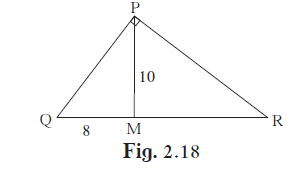In the given figure, ∠QPR = 90°, seg PM ⊥ seg QR and Q–M–R, PM = 10, QM = 8, find QR
Practice Set 2.1 | Q 3 | Page 38
In the given figure, ∠QPR = 90°, seg PM ⊥ seg QR and Q–M–R, PM = 10, QM = 8, find QR

In ΔPQR,
`{:(∠"QPR" = 90°),("seg PM ⊥ seg QR"):} }"Given"`
In a right angled triangle, the perpendicular segment to the hypotenuse from the opposite vertex, is the geometric mean of the segments into which the hypotenuse is divided.
∴ PM2 = QM × MR ...(Theorem of geometric mean)
∴ 102 = 8 × MR
∴ 100 = 8 × MR
∴ MR = `100/8`
∴ MR = 12.5
Now,
QR = QM + MR ...(Q-M-R)
∴ QR = 8 + 12.5
∴ QR = 20.5
Explanation:-
We are given a right-angled triangle ΔPQR, where ∠QPR = 90°, and PM is perpendicular to QR.
According to the theorem of geometric mean, in a right-angled triangle, the perpendicular segment to the hypotenuse from the opposite vertex is the geometric mean of the segments into which the hypotenuse is divided.
Therefore, we have:
PM^2 = QM × MR
Substituting the given values, we get:
10^2 = 8 × MR
Simplifying, we get:
100 = 8 × MR
Dividing both sides by 8, we get:
MR = 100/8
Simplifying further, we get:
MR = 12.5
Now, we can use the Pythagorean theorem to find the length of QR, which is the hypotenuse of the right-angled triangle.
We know that:
QR^2 = QM^2 + MR^2
Substituting the given values, we get:
QR^2 = 8^2 + 12.5^2
Simplifying, we get:
QR^2 = 64 + 156.25
QR^2 = 220.25
Taking the square root on both sides, we get:
QR = √220.25
QR = 20.5
Hence, we have found that the length of QR is 20.5 units.
Chapter 2 – Pythagoras Theorem- Text Book Solution
Practice Set 2.1 | Q 3 | Page 38
